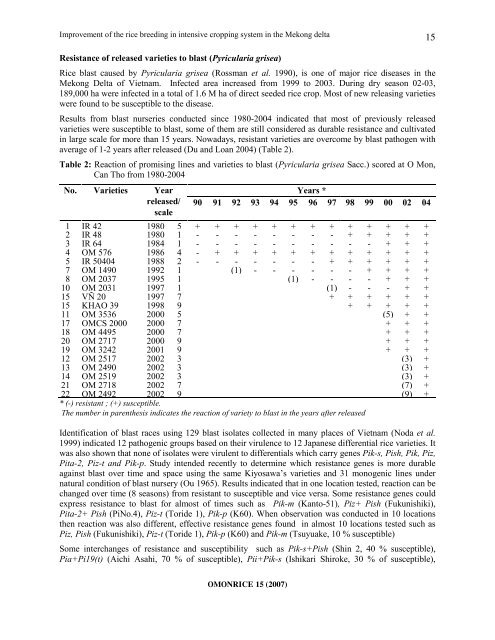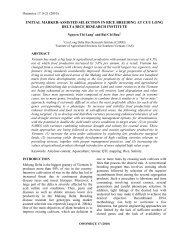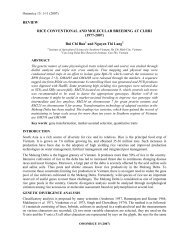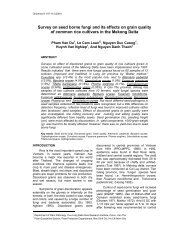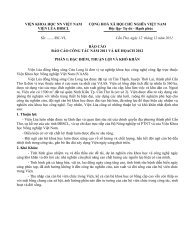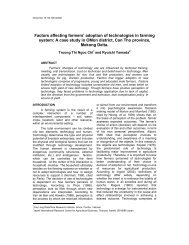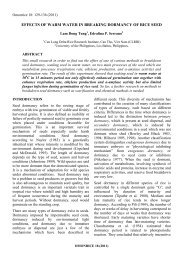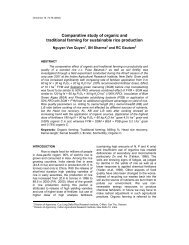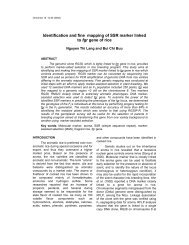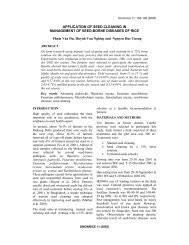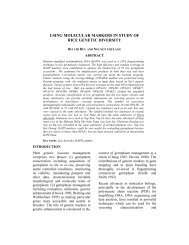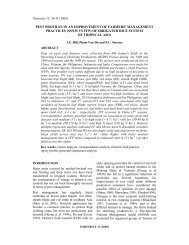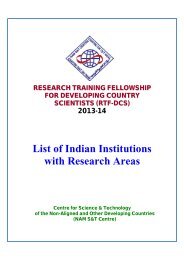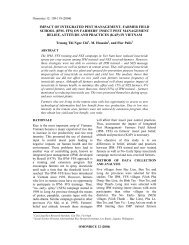REVIEW IMPROVEMENT OF THE RICE BREEDING IN INTENSIVE ...
REVIEW IMPROVEMENT OF THE RICE BREEDING IN INTENSIVE ...
REVIEW IMPROVEMENT OF THE RICE BREEDING IN INTENSIVE ...
Create successful ePaper yourself
Turn your PDF publications into a flip-book with our unique Google optimized e-Paper software.
Improvement of the rice breeding in intensive cropping system in the Mekong delta<br />
15<br />
Resistance of released varieties to blast (Pyricularia grisea)<br />
Rice blast caused by Pyricularia grisea (Rossman et al. 1990), is one of major rice diseases in the<br />
Mekong Delta of Vietnam. Infected area increased from 1999 to 2003. During dry season 02-03,<br />
189,000 ha were infected in a total of 1.6 M ha of direct seeded rice crop. Most of new releasing varieties<br />
were found to be susceptible to the disease.<br />
Results from blast nurseries conducted since 1980-2004 indicated that most of previously released<br />
varieties were susceptible to blast, some of them are still considered as durable resistance and cultivated<br />
in large scale for more than 15 years. Nowadays, resistant varieties are overcome by blast pathogen with<br />
average of 1-2 years after released (Du and Loan 2004) (Table 2).<br />
Table 2: Reaction of promising lines and varieties to blast (Pyricularia grisea Sacc.) scored at O Mon,<br />
Can Tho from 1980-2004<br />
No. Varieties Year<br />
released/<br />
scale<br />
Years *<br />
90 91 92 93 94 95 96 97 98 99 00 02 04<br />
1 IR 42 1980 5 + + + + + + + + + + + + +<br />
2 IR 48 1980 1 - - - - - - - - + + + + +<br />
3 IR 64 1984 1 - - - - - - - - - - + + +<br />
4 OM 576 1986 4 - + + + + + + + + + + + +<br />
5 IR 50404 1988 2 - - - - - - - + + + + + +<br />
7 OM 1490 1992 1 (1) - - - - - - + + + +<br />
8 OM 2037 1995 1 (1) - - - - + + +<br />
10 OM 2031 1997 1 (1) - - - + +<br />
15 VÑ 20 1997 7 + + + + + +<br />
15 KHAO 39 1998 9 + + + + +<br />
11 OM 3536 2000 5 (5) + +<br />
17 OMCS 2000 2000 7 + + +<br />
18 OM 4495 2000 7 + + +<br />
20 OM 2717 2000 9 + + +<br />
19 OM 3242 2001 9 + + +<br />
12 OM 2517 2002 3 (3) +<br />
13 OM 2490 2002 3 (3) +<br />
14 OM 2519 2002 3 (3) +<br />
21 OM 2718 2002 7 (7) +<br />
22 OM 2492 2002 9 (9) +<br />
* (-) resistant ; (+) susceptible.<br />
The number in parenthesis indicates the reaction of variety to blast in the years after released<br />
Identification of blast races using 129 blast isolates collected in many places of Vietnam (Noda et al.<br />
1999) indicated 12 pathogenic groups based on their virulence to 12 Japanese differential rice varieties. It<br />
was also shown that none of isolates were virulent to differentials which carry genes Pik-s, Pish, Pik, Piz,<br />
Pita-2, Piz-t and Pik-p. Study intended recently to determine which resistance genes is more durable<br />
against blast over time and space using the same Kiyosawa’s varieties and 31 monogenic lines under<br />
natural condition of blast nursery (Ou 1965). Results indicated that in one location tested, reaction can be<br />
changed over time (8 seasons) from resistant to susceptible and vice versa. Some resistance genes could<br />
express resistance to blast for almost of times such as Pik-m (Kanto-51), Piz+ Pish (Fukunishiki),<br />
Pita-2+ Pish (PiNo.4), Piz-t (Toride 1), Pik-p (K60). When observation was conducted in 10 locations<br />
then reaction was also different, effective resistance genes found in almost 10 locations tested such as<br />
Piz, Pish (Fukunishiki), Piz-t (Toride 1), Pik-p (K60) and Pik-m (Tsuyuake, 10 % susceptible)<br />
Some interchanges of resistance and susceptibility such as Pik-s+Pish (Shin 2, 40 % susceptible),<br />
Pia+Pi19(t) (Aichi Asahi, 70 % of susceptible), Pii+Pik-s (Ishikari Shiroke, 30 % of susceptible),<br />
OMON<strong>RICE</strong> 15 (2007)


